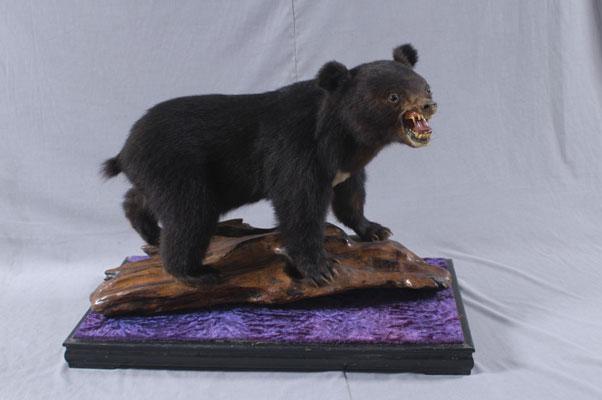TELDAP Collections
| The Pioneer of Research on Taiwan’s Natural History—Robert Swinhoe |
|
Retrospection on the 19th Century: The Beginning of Taiwan’s Naturalistic Studies
In the 19th century, a succession of adventurers from Western countries came to Taiwan to collect animal and plant specimens for research. The earliest record of animal collection was the insects collected by Arthur Adams (1820-1878) on the Green Island in 1845. But Robert Swinhoe was the first to collect specimens on the main island of Taiwan, and meanwhile organized them systematically on a large scale, thus pioneering the research on Taiwan’s natural history.
The Portrait of Robert Swinhoe
(Image Source, Archiving Institute: Library of Taiwan Forestry Research Institute)
Swinhoe and Taiwan
Robert Swinhoe (1836-1877) was born in the British colony of Kolkata, India. He had demonstrated an interest in zoology during his education in England, and once contributed a collection of birds, bird nests and eggs to the British Museum. After passing the examination for the British consular service in 1854, he left for Hong Kong to work and learn the Chinese language.
In 1856, he made his first trip to Taiwan, observing and making collections around Hsinchu. He went on a circumnavigation of Taiwan on board the British ship Inflexible in 1858, accompanied by the expert plant collector Charles Wilford (?-1893) from the Royal Botanic Gardens, Kew. He took up the post of British Vice-Consul in Taiwan in 1861, nominally subordinate to the British Consulate in Fuzhou. During these years, until his official appointment as the British Consul in Amoy in 1866, he had collected numerous specimens of animals and plants, in the meanwhile recording the natural and cultural conditions of Taiwan.
In addition to serving as the consul in Taiwan and making collections, Swinhoe published many important articles on Taiwanese mammals and birds. He also named a large number of species, such as Treron formosae formosae, Dendrocitta formosae, Parus monticolus insperatus, Ficedula hyperythra innexa, Stachyris ruficeps praecognita, Macaca cyclopis, Ursus thibetanus formosanus, Sus scrofa taivanus, Melogale moschata subaurantiaca, and Niviventer coxingi.
 Treron formosae formosae, subspecies endemic to Taiwan, inhabiting the dense, dark tropical forests.
(Image Source, Archiving Institute: National Museum of Natural Science)
 Ursus thibetanus formosanus, active year-round, mainly found in mid-elevation forests.
(圖片來源,典藏單位:國立臺灣博物館)
(Image Source, Archiving Institute: National Taiwan Museum)
 Melogale moschata subaurantiaca, subspecies endemic to Taiwan, found in low- and mid-elevation mountains
(Image Source, Archiving Institute: National Taiwan Museum)
The Taiwanese species named by Swinhoe or announced through his systematic collection encompass 227 species of birds, nearly 40 species of mammals, 246 species of plants, over 200 species of terrestrial snails and freshwater malacofauna, over 400 species of insects, and a number of amphibious reptiles, fishes and invertebrates. In memory of Swinhoe’s contribution, many species are named after him, including: ubus swinhoei, Euploea sylvester swinhoei, Paraglenea swinhoei, Nesiohelix swinhoei, Platyrhaphe swinhoei, Japalura swinhonis, Rhabdophis swinhonis, Rana swinhoana, Naemorhedus swinhoei, and Lophura swinhoii.
 Nesiohelix swinhoei, the young living in trees while the adult living in heaps of fallen leaves.
(Image Source, Archiving Institute: Biodiversity Research Center, Academia Sinica)
Swinhoe’s connection with Taiwan continued up to his last article published in 1877 before his death, On a New Bird from Formosa, where he introduced the bird specimens collected by Joseph Beal Steere (1842-1940) in Taiwan, and named a new species after him as Liocichla steerii. The specimens collected by Swinhoe have been of great value up to the present day, such as the specimen of Bolbocerosoma garritor now housed in the Museum National d'Histoire Naturelle in Paris, France, which had never been discovered again after Swinhoe’s example and was once believed to have gone extinct or to be nonexistent in Taiwan. It was not until 2004, around 150 years later, that another pair of specimens was collected by the team from the Department of Entomology, National Taiwan University, which proved the distribution of Bolbocerosoma garritor in Taiwan. This discovery not only marks a stride forward in the study of entomology, but also reminds us of Swinhoe’s contribution to Taiwan’s natural history.
Reference:
Yushan National Park Headquarters (2005) Conservation and Research of Formosan Black Bears. Available at: http://meibear.npust.edu.tw/ (Accessed: 25 June, 2010)
Li, C. L. (2007). Swinhoe and Taiwan’s Natural History─From the Rediscovery of Bolbocerosoma garritor. Taiwan Naturalistic Journal, 26 (4), 20-23.
Wu, Y. H. (1999). Plant Hunting in Taiwan: A History of Botanical Exploration in Taiwan in the 19th Century (1st ed.). Taichung City: Morning Star Publishing Inc.
Wu, Y. H. (2001). Animal Hunting in Taiwan: A History of Zoological Exploration in Taiwan in the 19th Century (1st ed.). Taichung City: Morning Star Publishing Inc.
Xu, Y. C., Chen, M. Y. & Lu, Y. M. (2008). Foreigner in Formosa: Robert Swinhoe (1st ed.). Taipei City: Dakang Publishing Inc., Xindian City, Taipei County: Academia Historica.
Chen, Z. S. (2008). Swinhoe in Formosa during Late Qing. Taipei City: Taiwan Classics Publishing House.
Chen, H. J. (2007). Words from the Curator of “Swinhoe in Formosa 1856-1866”. Taiwan Naturalistic Journal, 26 (4), 38-43.
Extended Reading:
CCC4: The Legend of Swinhoe in the 24th Century
|













